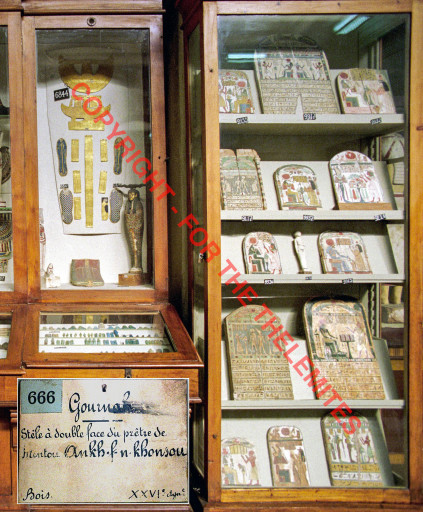── Note the PDF file/ebook below! ──

Boulak Museum


• Georges (Émile) (Jules) Daressy (1864-1938).

• The front of the new Cairo Museum at Kasr en-Nil. The museum had been open to visitors since early in August, 1902.

• The ancient Egyptian hieroglyph for “stele”. Painted wooden stelae, like Ankh-af-na-khonsu’s stele, occurred for the first time during the New Kingdom (c. 1569-1076 BCE), but they became more frequent found from the Third Intermediate Period, the period where Ankh-af-na-khonsu flourished.
CORRECTED VERSION WITH NEW ILLUSTRATIONS ADDED!
• Why did Aleister Crowley call the newly built Cairo Museum where his wife discovered the “Stélé of Revealing” for the “Boulak Museum”?
Read this detailed historical account of the various Egyptological museums in Egyptian history and discover the answer! Furthermore, the author has found proof that it, in fact, was the French assistant curator of the Cairo Museum, Georges Daressy, who wrote the documents containing the translations of the “Stèle 666”, which Crowley commissioned at the museum during the Cairo Working in 1904 E.V. However, there are strong indications suggesting that the work of the translations was initiated by the museum's French Director Gaston Maspero! – Read online or download this PDF file/ebook (53 pp.) containing an extract from FOR THE THELEMITES. [May need further proof reading]
(In connection with this extract, see also the two extracts found on the page “Ankh-af-na-khonsu”, and the extracts “The Replica”, and “Cairo Apartment”!)
Corrected version with new illustrations added. Read online or download (Acrobat 9.0 and later):

• Gaston (Camille) (Charles) Maspero (1846-1916).
• Winston Churchill, First Lord of the Admiralty, mentioned as late as 1939 E.V. ‘the Boulak Museum’ in Cairo, and furthermore gave his view on displaying dead corpses: “exposed to vulgar and unsympathetic gaze in the halls of the Boulak Museum.” – at that time the second World War had been going on for nearly 4 months. (Weekly Dispatch. London, England: Weekly Dispatch. ♦ Sunday Dispatch, December 31, 1939, p. 5.)

• Section from a French map of Cairo by L. Thuillier published in 1892. Top, left, Boulaq with the Boulaq Museum (№ 73).

• ‘Planche 15’ from Auguste Mariette’s impressive 1872 Album du Musée de Boulaq, exhibiting, among others, the Stele of Ankh-af-na-khonsu (reverse). The book had two plates (14 & 15) whereon the stele could be seen – the first time the stele was depicted in a published work. On the back of the stele is written the beginning of Chapter XXX of the Book of Going Forth by Day (‘The Book of the Dead’), and the fact that it normally is to be found engraved upon funeral scarabs must have astonished Mariette, and therefore the stele’s reverse was exhibited.

• The funeral stele of Ankh-af-na-khonsu i (died c. 700-675 BCE in the late twenty-fifth Dynasty) exhibited in the Cairo Museum – the museum in which Rose Crowley discovered it in March 1904 E.V.! The front side of the stele is seen to the right on the 2nd shelf from the bottom. Inserted at the bottom of the photo is the old label attached to the stele of Ankh-af-na-khonsu i. In 1904 E.V. the stele was exhibited in the upper floor's 'Room F', and here it is seen in its ‘modern’ location in ‘Room 22’ on the upper floor in the end of the 1990s. The stele's current location is the new ‘The Grand Egyptian Museum’ in Giza.

• French humorous illustration from the Egyptian section of the Paris Universal Exhibition of 1867. Its text stated: « Vrai ! les anciens égyptiens n’étaient pas beaux. » – True! The Ancient Egyptians were not beautiful.
You might need Adobe Reader in order to open a PDF file. Install Adobe Acrobat Reader DC (free version) on your computer or mobile device:
Copyright © Perdurabo ST — All Rights Reserved 2025 E.V.
